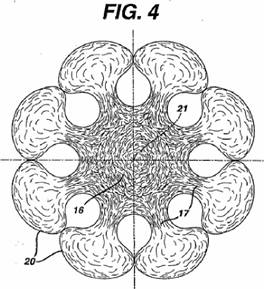After McNeil appealed obviousness rejections to the US Patent and Trademark Office Board of Patent Appeals and Interferences, the Board dismissed the whole business as filed in an untimely manner. McNeil took the case to the US Court of Appeals for the Federal Circuit who sided with them that the appeal was timely and the patent rejections were bogus. In re McNeil (08-1546).

McNeil asked that the PTO reexamine its ‘269 patent (re-examination No. 90/006,467) based on an unexamined Japanese application by Tetsu Sasaki, No. 55-168330. In light of Sasaki, the examiner rejected claims 1 and 3 as anticipated and claim 4 as obvious.
McNeil appealed to the Board, arguing that Sasaki did not disclose the relative densities or coarseness of the core and ribs on the tampon. McNeil also disputed that Sasaki disclosed ribs which were narrower at the base than at the proximal end.
The Board affirmed the examiner’s rejection so McNeil filed a request for rehearing, objecting to the Board making findings of fact in the first instance and arguing against the rejections on the merits. The Board denied the request saying they were a day late and a dollar short.
It turned out that the typed date on the face of the Board order denying McNeil’s request for rehearing was “May 30, 2008.” The mailing sheet for the order was dated June 2, 2008. The online “Transaction History” for the reexam has two entries for May 30, 2008: “Mail BPAI Decision on Reconsideration – Denied” and “Dec on Reconsideration – Denied.”
The image file wrapper (“IFW”), which is also available online, lists the “Mail Room Date” of the decision as June 2, 2008. McNeil filed a notice of appeal on August 1, 2008. The Director responded that the appeal was untimely because it was filed more than sixty days after the Board made its final decision on May 30, 2008. Hence, the Federal Circuit looked at the whole mess:
We address first, as we must, whether McNeil’s appeal is timely. Compliance with the PTO rules regarding the time for an appeal is required by statute, and while the Director can grant extensions of time, we cannot. See In re Reese, 359 F.2d 462, 463 (CCPA 1966) (per curiam).
Congress gave the Director some authority to set the time for filing an appeal:
When an appeal is taken to the United States Court of Appeals for the Federal Circuit, the appellant shall file in the Patent and Trademark Office a written notice of appeal directed to the Director, within such time after the date of the decision from which the appeal is taken as the Director prescribes, but in no case less than 60 days after that date. 35 U.S.C. § 142 (emphasis added).
The regulations promulgated under this statute provide, in pertinent part:
The time for filing the notice of appeal to the U.S. Court of Appeals for the Federal Circuit (§ 1.302) or for commencing a civil action (§ 1.303) is two months from the date of the decision of the Board of Patent Appeals and Interferences. If a request for rehearing or reconsideration of the decision is filed within the time period provided under § 41.52(a), § 41.79(a), or § 41.127(d) of this title, the time for filing an appeal or commencing a civil action shall expire two months after action on the request. 37 C.F.R. § 1 .304(a)(1).
The crux of the matter is what the phrase “the date of the decision” means. The second sentence of the regulation quoted above actually uses different phrasing to set the time to appeal from decisions on requests for reconsideration (i.e., “action on the request”), but the intent is that the same sixty-day rule (and not some shorter time period) applies after a denial of a request for reconsideration.
The PTO argued that both 35 U.S.C. § 142 and 37 C.F.R. § 1 .304(a)(1) state that the time to appeal runs from “the date of decision,” and the opinion says “Decided: May 30, 2008,” so it would be contrary to the language of the statute and the regulation for us to deem the date of decision to be the date the order was mailed.
The Federal Circuit felt sympathy in its heart that day:
While this argument has some superficial appeal, the inner workings of the agency are far more important than the PTO admits. Based on the evidence before us, it appears that only when an opinion is released to the public (or at least the parties) is it truly decided—until then, it is possible for the Board to decide to revise it.
Because we determine that McNeil’s appeal is timely, we reach the merits and, because the Board of Patent Appeals and Interferences findings about the disclosures of a prior art patent application are not supported by substantial evidence, we reverse the claim rejections.
Circuit Judge Dyk, dissenting, felt that the date on the face was clear:
The decision of the Board of Patent Appeals (“Board”) clearly states on its face that it was “Decided: May 30, 2008.” Because McNeil did not appeal until August 1, 2008, two days after the regulatory period for review from a decision of May 30, 2008, in my view this appeal was untimely filed and is beyond our jurisdiction to review. I respectfully dissent from the majority’s contrary conclusion.
The majority appears to hold that the “date of the decision” is not the date of decision as clearly written on the opinion, but is instead the date of mailing. In my view, this holding is contrary to the plain language of the regulation and precedent interpreting the nearly identical language of the predecessor rule.
